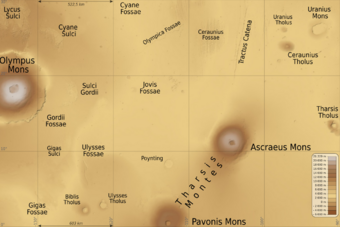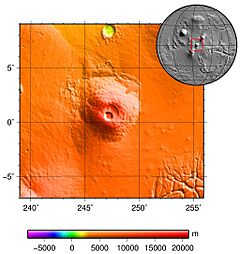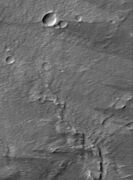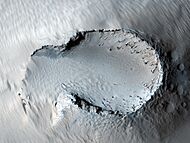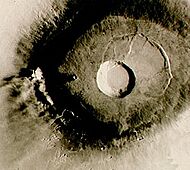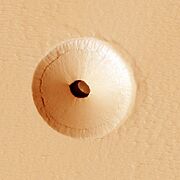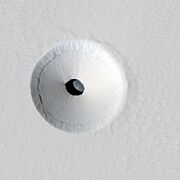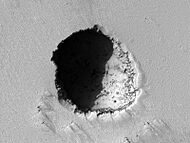Pavonis Mons facts for kids
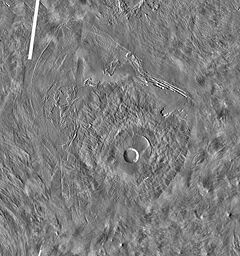
This image of Pavonis Mons was taken by the THEMIS camera. The fan-shaped area to the northwest is thought to have been created by ancient glaciers.
|
|
| Feature type | Shield volcano |
|---|---|
| Coordinates | 1°29′N 247°02′E / 1.48°N 247.04°E |
| Peak | 8.7 km (5.4 mi) 28,543 ft (8,700 m) |
| Discoverer | Mariner 9 (1971) |
| Eponym | Latin for "Peacock Mountain" |
Pavonis Mons is a giant shield volcano on the planet Mars. Its name is Latin for "Peacock Mountain." It is the middle volcano in a chain of three huge mountains known as the Tharsis Montes, which are located near the Martian equator.
The volcano was discovered in 1971 by the Mariner 9 spacecraft. Because of its great height and location on the equator, some scientists think Pavonis Mons would be a perfect place to build a space elevator in the future.
Contents
General Description
Pavonis Mons is located in a large, raised area on Mars called the Tharsis region. It sits about 400 km away from its two neighbors, Ascraeus Mons to the northeast and Arsia Mons to the southwest. These three volcanoes form a straight line. Nearby is Olympus Mons, the tallest volcano in the entire Solar System.
Size and Shape
Pavonis Mons is the smallest of the three Tharsis Montes volcanoes, but it is still enormous. It measures about 375 km across and is 14 km tall.
It is a shield volcano, which means it has very gentle slopes, averaging only 4 degrees. This makes it look like a warrior's shield lying flat on the ground. At its peak, there is a deep, circular crater called a caldera. This caldera is 47 km wide and almost 5 km deep.
A Dusty Volcano
Like much of the Tharsis region, Pavonis Mons is covered in a thick layer of fine, bright dust. This dust covers up many of the smaller details on the volcano's surface.
The reason it's so dusty is because of its high altitude. The air at the top of Pavonis Mons is very thin. The atmospheric pressure is only about 21% of the average pressure on Mars. This thin air is not strong enough to blow away dust once it settles on the ground.
Geology of Pavonis Mons
The surface of Pavonis Mons is made of lava flows from the Amazonian period, the most recent period in Mars's history. The volcano's northern side has many long cracks and valleys that circle its summit. On its lower eastern side, there is a chain of oval-shaped pits that formed when the ground collapsed along fault lines.
Glaciers on Mars?
Scientists studying images from spacecraft like the MGS and Odyssey believe that glaciers once existed on Pavonis Mons. In fact, some ice may still be there today, buried under dust and rock.
Evidence for these ancient glaciers includes:
- Concentric ridges that look like moraines, which are piles of rock and dirt left behind by moving glaciers on Earth.
- Knobby terrain, which may have been formed when buried ice turned directly into gas (a process called sublimation).
- Smooth areas that appear to be debris-covered glaciers flowing over the landscape.
This ice could be a very important resource for future human explorers on Mars.
A Clue to Plate Tectonics
The three Tharsis Montes volcanoes form a remarkably straight line. Some scientists have suggested that this could be evidence of plate tectonics on Mars, similar to what happens on Earth.
On Earth, a chain of volcanoes like the Hawaiian Islands can form when a tectonic plate slowly moves over a stationary "hot spot" of magma from deep within the planet. It is possible that the Tharsis Montes formed in a similar way, providing a clue about the geologic history of Mars.
Gallery
-
The summit caldera of Pavonis Mons.
-
A 35-meter wide hole that is a skylight into an underground lava tube.
See also
- List of mountains on Mars by height
- Tharsis quadrangle


